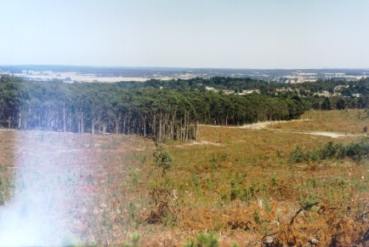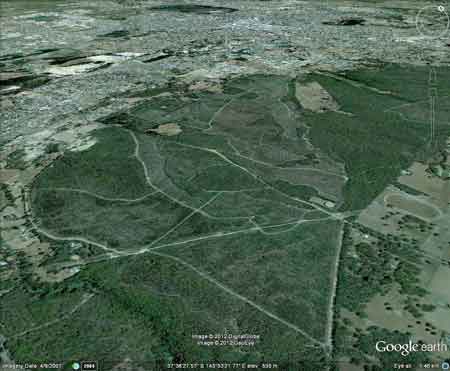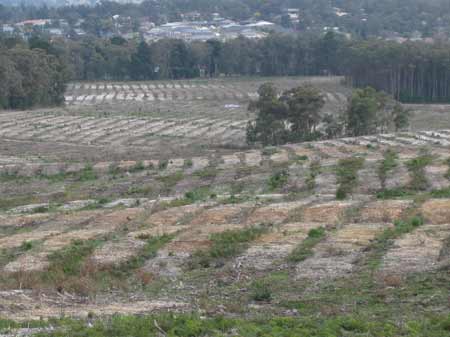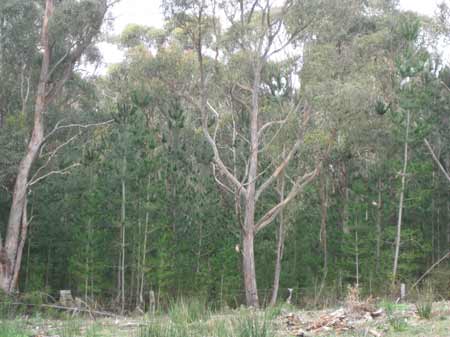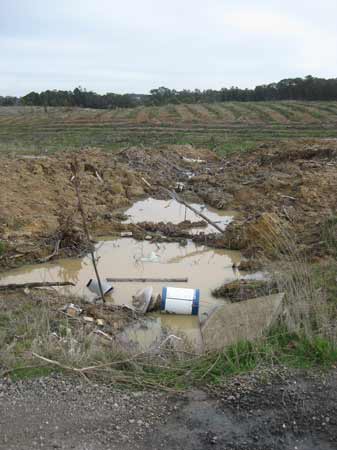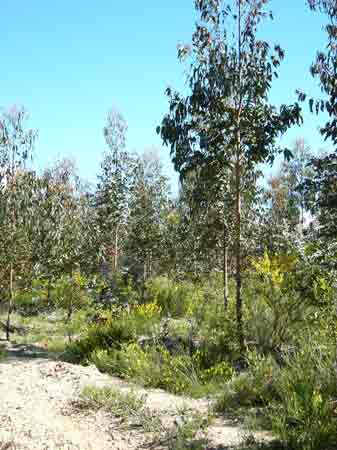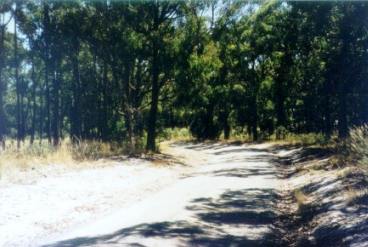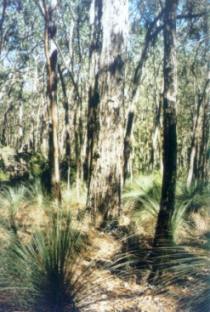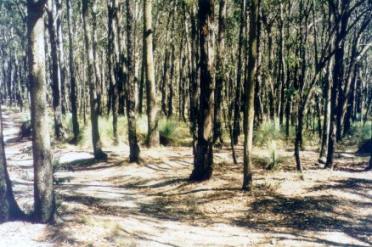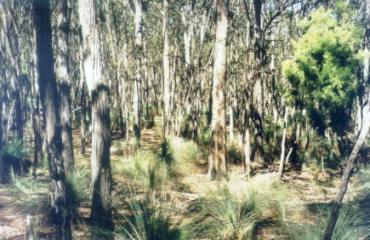Plantation replanted with approximately 300,000 bluegums in 2002. Area now likely to be leased by EPFL (East Victorian Plantation Forest Company of Australia Pty Ltd) who are a consortium of Japanese paper manufacturers and a trading house. EPFL has a Heads of Agreement for the sale of bluegum with Enviroinvest. The Nationally Threatened Temperate Grassland & Grassy Eucalypt Woodland Ecological Community may occur in this plantation or in close proximity. More Information: http://www.environment.gov.au/epbc/publications/pubs/grasslands-victoria.pdf
Plantation lies about 3km south east of the CBD of Ballarat and about 0.5-1km east of the Ballarat suburb of Mount Clear. The plantation is a high fire risk due to its close proximity to Ballarat.
August 2012: Entire bluegum plantation cut out in early 2012. Bluegums logged on ten year rotation.
August 2012: Pine wildings growing within native vegetation. These trees look like they could be about 5-10 years old and should be Hancock's responsibility to remove. Radiata pine are a noxious weed in Victoria.
August 2012: Blocked drainage line in plantation. Busted Culvert and now a used as a rubbish dump. January 29 2011: Petition To Get Rid Of Pine Plantations November 5 2010: Mt Helen Permit Fix Close October 8 2010: CFA Chief Speaks on Mt Helen Permits October 7 2010: Mt Helen Building Permits Council Moves To End Stalemate August 7 2010: Housing Permits Denied Due To Mt Helen Fire Risk Plantation within AKD Softwoods area of supply. Plantation within SPE Exports (Geelong) area of supply. Plantation where the Secretary CNR retains specified rights to harvest hardwood sawlogs. Click here for map of Hancocks' Ballarat region plantations. This plantation was very likely to be aerially sprayed with 2,4,5-T between 1968 and 1977. The Dioxin TCDD may still exist in soil in this plantation. For more historical data on 2,4,5-T click here. For more information concerning the continuing health crisis concerning 2,4,5-T please forward to here. THREATENED FISH NOTES - BARWON RIVER: Probably Blackfish in mid to upper reaches. The lower reaches have 1 of 2 of the main spawning areas for Australian Grayling west of Melbourne.
November 2005: This plantation was planted out in 2002 with 300,000 Tasmanian Bluegums most likely by EPFL (East Victorian Plantation Forest Company of Australia Pty Ltd). Some of the trees are already looking stressed. Soils: Sourced from Geological Maps of Victoria Oll: Ordovician/Lancefieldian: Deep marine deposits: sandstone and mudstone and black shale; dominantly sand-rich turbidite facies, moderately to well sorted, variably rounded quartz with minor feldspar and lithic grains in quartz silt or clay matrix, medium to very thick bedded; sparsely fossil iperous with phyllocarids and grapholites, weathered to partly Kaolinised. Qrc: Quaternary/Recent: Colluvial deposits, active outwash fans, scree aprons and colluvium, ubiquitous around hill bases and in gullies, polymictic gravel, sand, silt, clay: poorly sorted, variably rounded, stratified, laminated or massive. Qpc: Dissected colluvial deposits in active outwash fan; scree apron and alluvial-colluvial swamp deposits; polymictic gravel, sand, silt and clay; variably sorted and rounded, stratified, laminated or massive. Tlw: Palaeocene/Eocene: White Hills Gravel: Alluvial broad plain, outwash fan and scree deposits: dissected hill-capping to hill-flanking sheet; dominated by well rounded; high sphericity vein quartz pebbles and cobbles, less more angular vein quartz and bedrock clasts; moderately to well sorted, massive to crudely stratified, occassionally channeled, variably ferruginised, silicified or kaolonised, auriferous in parts.
November 2005: Wildlings dominate the Canadian State Forest. If the plantation is no longer leased by Hancock, but EPFL, who is responsible for weed control, including radiata pine wildings that may have germinated during the lease of the previous owners? Responsible Authority: Ballarat City Council Plantation Catchment: Several creeks flow north and west into Yarowee River/Barwon River. Catchment Managment Authority: Corangamite Catchment Management Authority Hancock Watch Site visit Feb 01: Entered site from east along Recreation Road. Quite large portions of native vegetation remaining in this plantation. It appears Hancock has avoided clearing this native vegetation which appeared in at least 8 locations through the site. The most extensive stand of forest included grass trees lieing south of Recreation Road. Some wildings seen on eastern edge of the plantation. Second plantation area to the north east was all pine and there is a DNRE concession area in the north east corner of the main mass of plantation which appeared to have very few trees widely spaced. Interestingly plantation in close proximity to Ballarat. May be a reason why at least 15% of plantation is native forest. Appeared to be failed regeneration in northern aspect of plantation. Pine seedlings did not appear to be located as close to each other as in other plantations. Yarrowee River: Also known as the Leigh River. Flows through grazing land, mud bottom. Polluted and is unsafe for drinking or swimming. Water level can become low in summer. Carries some brown trout to 900g, average size is smaller, redfin to 450g, eels and tench. Source: A Guide to the Inland Angling Waters of Victoria by BR Tunbridge, PL Rogan, CA Barnham. Department Conservation and Environment. Arthur Rylah Institute for Environmental Research, 123 Brown St, Heidelberg, 3084. (4th ed - 1991)
|
